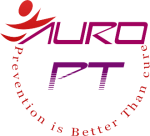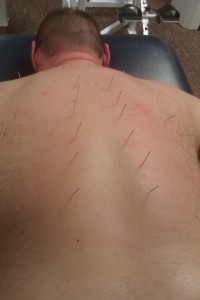What is intramuscular manual therapy?
Intramuscular manual therapy (aka., dry needling) is the insertion of a filament needle directly into or over a Myofascial trigger point in order to release tension and decrease pain. A trigger point is characteristic of ‘Myofascial Pain Syndrome which is a common muscle pain disorder. Intramuscular manual therapy has been shown to produce analgesia in 87% of sites needled. Results of intramuscular manual therapy include a decrease in subjective complaints, a reduction in the need for medication and decreased stiffness.
What is a trigger point?
A trigger point has been defined as taut band of muscle that has become hyperirritable as a result of either macrotrauma or repetitive microtrauma. When compressed, pain is elicited either at the trigger point or referred to another location on the body. Electrical activity and the biochemical make-up is altered at the trigger point. The muscle becomes fatigued and is at increased risk for further injury.
How does intramuscular manual therapy work?
There are a number of proposed methods for dry needling, direct needling of the trigger point, needling the skin over the trigger point, or needling the muscles associated with the spinal nerve innervation. In trigger point needling, rapidly inserting a needle into the muscle causes a local twitch response, which can alter the pathological mechanism of the trigger point. The local twitch response inhibits abnormal electrical noise at the nerve-muscle junction and changes the chemical milieu within the muscle. The needle is left in place for approximately 10 minutes or until the muscle relaxes and the pain diminishes.
Where did intramuscular manual therapy originate?
Dry needling dates back to as early as the 7th century where Sun-Ssu-Mo, a Taoist doctor, used needling on what he called Ah-Shih points, which corresponds with modern day trigger points. Dry needling reached Europe in the 17th century bit it was not until Dr. Travell and Dr. Simons, American Medical Physicians, published The Trigger Point Manual and Dr. Lewit introduced deep dry needling for trigger points, that intramuscular manual therapy became more popular in the United States.
What are the risks of intramuscular manual therapy?
Intramuscular manual therapy is a low risk procedure. Minor adverse events include bleeding, bruising, pain at site of insertion and aggravation.
What conditions can be treated by dry needling?
The purpose of intramuscular manual therapy is to treat Myofascial pain. It has been suggested that intramuscular manual therapy can also be useful in treating:
· Low Back Pain · Headaches · Frozen Shoulder · Tennis Elbow · Power Spasms · Fibromyalgia · Sciatic Pain · Hip/Knee Pain · Repetitive Strain Injuries · Temporomandibular disorders · Tendinitis/Tendinosis

